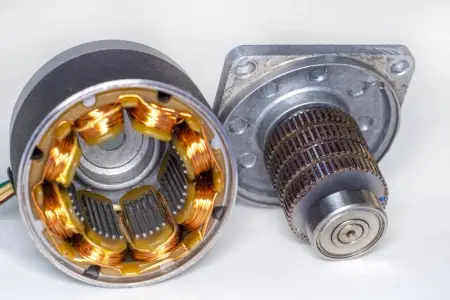
The electric motor is a motor whose objective is to transform electricity into kinetic energy.
The motor consists of a rotating part, a rotor and a fixed part, a stator. Distinguish between DC motors and AC motors. The latter are divided into synchronous motors and asynchronous motors. Asynchronous motors, in turn, are divided into asynchronous motors with a short-circuited rotor (the so-called squirrel cage) and a phase rotor
Despite the existence of multiple types of electric motors, most have certain elements in common:
Rotor
In an electric motor, the moving part is the rotor, which rotates the shaft to deliver mechanical power. The rotor generally has conductors installed that carry currents, which interact with the magnetic field of the stator to generate the forces that rotate the shaft. Alternatively, some rotors carry permanent magnets, and the stator holds the conductors.
Bearings
The rotor is supported by bearings, which allow the rotor to rotate on its axis. The bearings are in turn supported by the motor housing. The motor shaft extends through the bearings towards the outside of the engine, where the load is applied. Because the forces of the load are exerted beyond the outermost bearing, the load is said to be suspended.
Stator of an electric motor
The stator is the stationary part of the electromagnetic circuit of the motor and generally consists of permanent windings or magnets. The stator core is formed by many thin metal sheets, called laminations. Laminations are used to reduce the energy losses that would result if a solid core were used.
Air space
The distance between the rotor and the stator is called the air gap. The air space has important effects, and is generally as small as possible, since a large space has a strong negative effect on performance. It is the main source of the low power factor in which the engines operate. The magnetization current increases with the air gap. For this reason, the air space must be minimal. Very small gaps can present mechanical problems in addition to noise and losses.
Electromagnetic coils
An electromagnetic electromagnetic coil is an electrical conductor such as a coil, spiral or helix wire. Electromagnetic coils are used in electrical engineering, in applications where electric currents interact with magnetic fields
Windings are wires that are placed in coils, usually wrapped around a soft iron laminated magnetic core to form magnetic poles when energized with current.
Some engines have conductors that consist of thicker metals, such as bars or sheets of metal, usually copper, or aluminum. These are usually powered by electromagnetic induction.
Electric motor switch
A switch is a mechanism used to change the input of most direct current machines and certain alternating current machines. It consists of sliding ring segments isolated from each other and from the shaft. The motor armature current is supplied through stationary brushes in contact with the rotary switch, which causes the required current inversion, and optimally applies energy to the machine as the rotor rotates from pole to pole.
In the absence of such a reversal of current, the motor would stop. In the light of improved technologies in the fields of electronic controller, sensorless control, induction motor and permanent magnet motor, externally switched induction and permanent magnet motors are displacing motors with electromechanical switching.